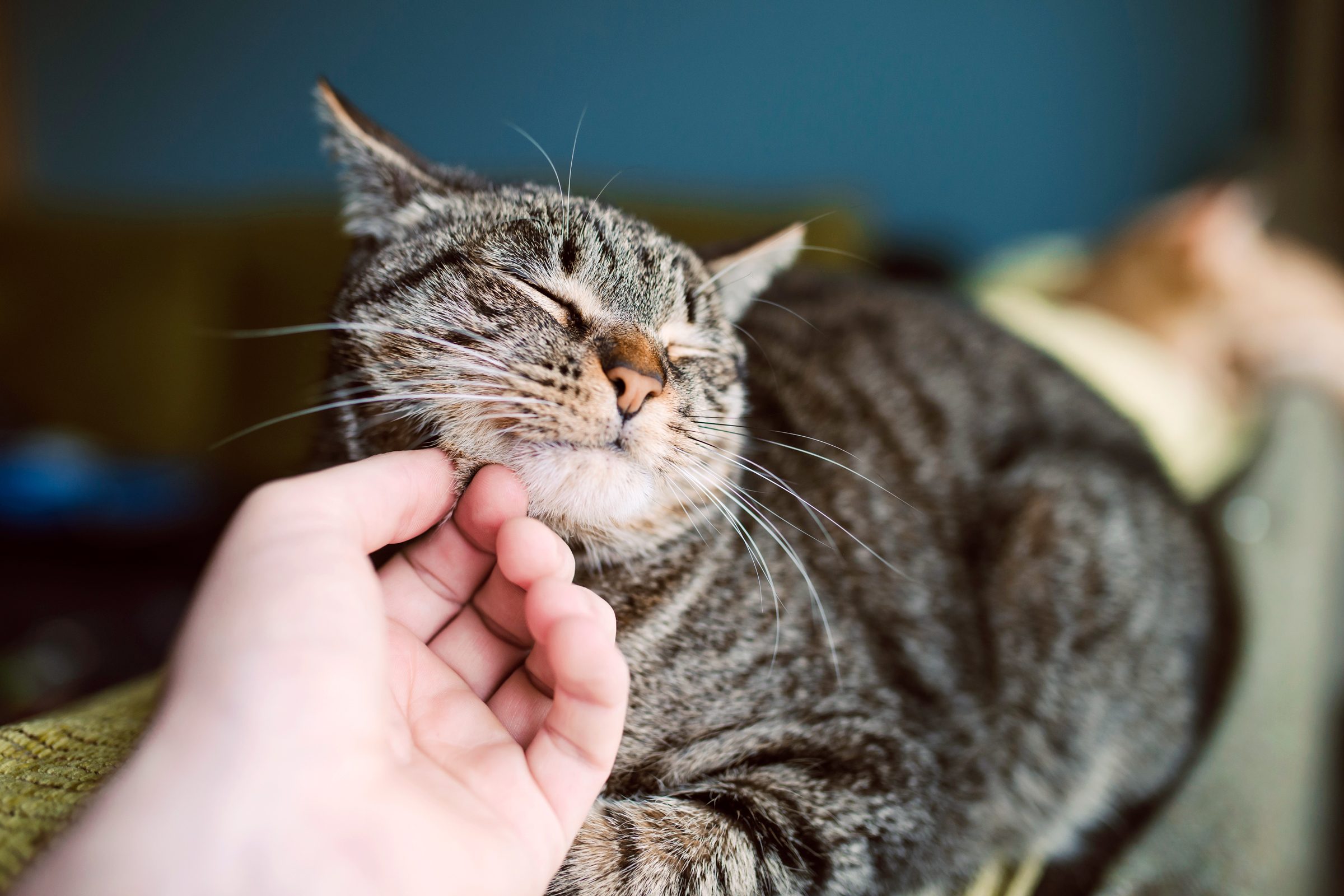To get your cat’s heart rate while purring, gently place your hand on their chest. Count the beats for 15 seconds and multiply by four.
Monitoring your cat’s heart rate is crucial for their overall health. Purring can make it challenging, but it is possible with patience. Ensure your cat is calm and relaxed before you begin. Use a timer to help you count accurately.
A normal heart rate for cats ranges between 140 and 220 beats per minute. If you notice any irregularities, consult your veterinarian immediately. Regular monitoring helps detect potential health issues early. Always handle your cat gently to avoid stress during the process. This routine can become an essential part of your pet care.

Credit: www.amazon.com
Contents
Necessary Tools
Measuring your cat’s heart rate while purring can be a bit challenging. To make this task easier, you’ll need some necessary tools. Using the right equipment ensures accuracy and keeps your cat comfortable.
Basic Equipment
The basic tools for measuring your cat’s heart rate include:
- Stopwatch or a clock with a second hand
- Comfortable space for your cat to sit
- Notebook and pen for recording the heart rate
First, find a quiet space. Then, let your cat sit calmly. You can use the stopwatch to count the beats. Note down the number of beats in 15 seconds. Multiply this number by four. This gives you the heart rate per minute.
Optional Gadgets
For more accuracy, you can use advanced gadgets:
- Stethoscope – Helps you hear the heartbeats clearly.
- Heart rate monitor – Digital device to record heart rate.
- Smart collar – Tracks various health metrics including heart rate.
Using a stethoscope, place it gently on your cat’s chest. Count the beats for 15 seconds. Use the same multiplication method. Digital heart rate monitors are easier to use. Simply attach the monitor to your cat. It will show the heart rate automatically.
A smart collar provides continuous monitoring. It tracks the heart rate and other health metrics. You can check the data through a connected app. This gives you a comprehensive view of your cat’s health.

Credit: www.amazon.com
Creating A Calm Environment
Creating a calm environment is essential to get your cat’s heart rate. Cats are sensitive creatures who need a peaceful setting. This makes them feel safe and relaxed. Below, we’ll cover the steps for choosing the right time and setting up the space.
Choosing The Right Time
Select a time when your cat is most relaxed. This is usually after meals or during their nap times. Ensure there are no distractions around. Turn off loud devices and keep the surroundings quiet. A calm environment ensures accurate heart rate readings.
Setting Up The Space
Prepare a cozy spot for your cat. Use soft blankets or their favorite bed. Cats love comfort, and this will help them stay calm. Make sure the space is away from high-traffic areas. A quiet corner in your home works best.
Additionally, keep the lighting dim. Bright lights can stress your cat. Soft, natural light is ideal. Use a gentle voice and slow movements. This reassures your cat and keeps them relaxed.
| Item | Purpose |
|---|---|
| Soft blankets | Provide comfort |
| Favorite bed | Familiar space |
| Quiet corner | Reduces distractions |
| Dim lighting | Creates a calm atmosphere |
- Turn off loud devices
- Keep surroundings quiet
- Use a gentle voice
- Make slow movements
Following these steps helps in creating the perfect environment. Your cat will feel safe and you can get an accurate heart rate while they purr.
Locating The Heartbeat
Checking your cat’s heart rate, especially while they are purring, can be a bit tricky. Cats’ purrs can mask their heartbeat sound. Knowing where to place your hands is crucial. This guide will help you find the best spots to feel your cat’s heartbeat and how to use a stethoscope effectively.
Best Spots To Feel
There are several spots where you can feel your cat’s heartbeat. These spots are close to the surface and less covered by thick fur.
- Chest: Place your hand behind the front leg, near the elbow.
- Left Side: Feel the left side of your cat’s chest, behind the front leg.
- Behind the Front Paw: Gently press behind the front paw to feel the pulse.
Gently apply pressure to these spots. Don’t press too hard, just enough to feel the beats. Make sure your cat is calm and relaxed. This will make it easier to detect the heartbeat.
Using A Stethoscope
A stethoscope can make it easier to hear your cat’s heartbeat. Here are some simple steps to follow:
- Place the stethoscope’s diaphragm on the same spots mentioned above.
- Press it gently against your cat’s chest.
- Listen carefully for the heartbeat. It may be faint due to purring.
Tips for Using a Stethoscope:
- Try to keep your cat calm and still.
- Use a quiet room to avoid background noise.
- Adjust the earpieces for a comfortable fit.
Using a stethoscope can help you get a clear reading. This is especially useful if your cat’s purring is too loud.

Credit: www.rd.com
Measuring The Heart Rate
Checking your cat’s heart rate while it purrs can be tricky. Purring can mask the actual heartbeats. Still, it’s possible with patience and the right method. Here are some simple steps to measure your cat’s heart rate accurately.
Counting Beats
First, find a quiet, calm environment. Gently place your hand on your cat’s chest. Feel for the steady thumping of the heart.
- Use your fingertips, not your palm.
- Focus on the beats, ignoring the purring.
Count the beats you feel in a set time. It’s best to count for 15 seconds. Then, multiply by four to get the beats per minute (BPM).
Using A Timer
A timer helps measure time accurately. Use a stopwatch or a phone timer.
| Time (Seconds) | Multiply Factor |
|---|---|
| 15 | 4 |
| 30 | 2 |
Start the timer and count the beats for the chosen time. Multiply the count by the factor to get BPM. For example, if you count 20 beats in 15 seconds, the BPM is 80.
Repeat the process to ensure accuracy. Always handle your cat gently to keep it calm during the measurement.
Recording The Data
Recording your cat’s heart rate while purring helps monitor their health. This process requires precision and consistency. Here’s how to keep an accurate record.
Keeping A Log
Start by keeping a dedicated logbook or digital file. Use a table to record the data for easy reference.
| Date | Time | Heart Rate | Notes |
|---|---|---|---|
| 01/01/2023 | 10:00 AM | 150 bpm | Cat was calm. |
| 01/02/2023 | 02:00 PM | 140 bpm | Cat was playful. |
Update the log regularly. Make sure to note the heart rate and any observations.
Noting Purring Patterns
Observe your cat’s purring patterns. Note the duration and intensity of their purrs. This can help identify any changes in their behavior.
- Short, soft purrs may indicate relaxation.
- Long, loud purrs might signal contentment or distress.
Include these observations in your log. This data can be useful for your vet.
- Listen to your cat’s purrs.
- Note the time and environment.
- Record any changes in purring patterns.
This detailed record will help you understand your cat’s health better. Consistent tracking is key to accurate data.
Interpreting Results
Measuring your cat’s heart rate while purring can be tricky. Knowing how to interpret these results is crucial. This will help you understand your cat’s health better.
Normal Heart Rate Range
A cat’s normal heart rate ranges between 140 to 220 beats per minute. This range can vary based on age, size, and activity level. Here’s a simple table to help you understand better:
| Cat’s Condition | Heart Rate (beats per minute) |
|---|---|
| Resting | 140 – 180 |
| Active | 180 – 220 |
If your cat’s heart rate is within this range while purring, this is normal. Always ensure you measure when the cat is calm.
When To Seek Vet Advice
If your cat’s heart rate is below 140 or above 220 beats per minute, seek a vet’s advice. This could indicate a health issue.
- Below 140: Possible bradycardia or other issues.
- Above 220: Possible tachycardia or stress-related issues.
Observe other symptoms like:
- Lethargy
- Panting
- Loss of appetite
These symptoms, combined with an abnormal heart rate, require immediate vet consultation. Early detection can save your cat’s life.
Tips And Precautions
Measuring your cat’s heart rate while they are purring can be challenging. It requires patience and care. Here are some essential tips and precautions to ensure you get an accurate reading. Follow these steps to keep your cat calm and stress-free.
Avoiding Stress
- Choose a quiet room where your cat feels safe.
- Pet and comfort your cat before starting.
- Use gentle movements to avoid startling your cat.
- Wait until your cat is relaxed and purring calmly.
Ensuring Accurate Readings
- Place your hand gently on your cat’s chest.
- Feel for the heartbeat with your fingers.
- Use a stopwatch to count beats for 15 seconds.
- Multiply the number of beats by four for the heart rate per minute.
Here are some additional tips for accurate readings:
| Tip | Description |
|---|---|
| Use a Timer | Ensure you have a reliable stopwatch or timer. |
| Consistency | Measure the heart rate at the same time daily. |
| Position | Keep your cat in the same position each time. |
Frequently Asked Questions
Does Cat Breathing Rate Increase When Purring?
Yes, a cat’s breathing rate can increase when purring. This is normal and usually not a cause for concern.
How Can I Take My Cats Heart Rate?
To take your cat’s heart rate, place your hand on their chest behind the front leg. Count the beats for 15 seconds. Multiply by four to get beats per minute. Normal range is 140-220 beats per minute.
Where Would You Listen To Get A Heart Rate On A Cat?
Listen to get a cat’s heart rate by placing a stethoscope on the left side, just behind the front leg.
Where Is The Best Place To Feel A Cat’s Heartbeat?
The best place to feel a cat’s heartbeat is on its left side, just behind the front leg. This area provides a clear and strong pulse. Gently place your hand there and wait for the rhythmic beat.
Conclusion
Measuring your cat’s heart rate while purring can be simple with patience and practice. Use a stopwatch and gentle touch. Understanding their health ensures a happier, longer life. Always consult a vet for professional advice. Your cat’s well-being is worth the effort.
Happy purring and heart rate monitoring!

Katie Lindsey is a passionate cat lover and founder of Cats Solution, a comprehensive resource for all things feline. With a lifelong love for cats and extensive knowledge in their care and behavior, she provides expert advice and solutions to cat owners. Through her website, Katie fosters a supportive community where cat enthusiasts can find guidance and heartwarming stories. A dedicated advocate for animal welfare, Katie also promotes responsible pet ownership and adoption. Join her on this purr-fect journey celebrating the joy of feline companionship.



